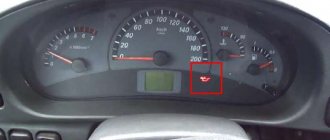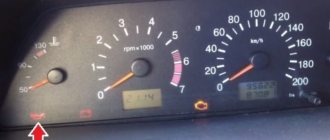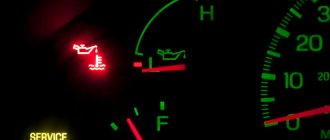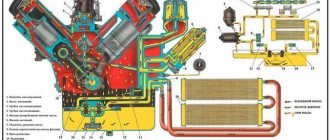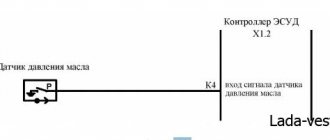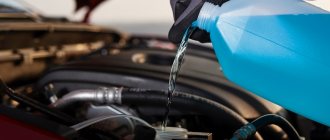There is one of the indicators on the dashboard of cars that informs the driver about a decrease in oil pressure in the engine unit. The so-called oil pressure light in the form of an oil can signals a critical condition of the engine - insufficient amount of lubricant. On the panels of VAZ “classic” cars (six, seven, nine) there is also such an indicator. And if it suddenly lights up while driving or at low speeds while parked, this is a signal that there is a malfunction in the engine.
Why does the oil pressure light come on in a VAZ classic?
The first step is to distinguish cases when an icon in the form of an oil can is suddenly displayed. It is completely safe for the icon to light up for just a few moments in the following cases:
- when there is a strong roll of the car on a sharp turn;
- when starting in winter;
- after a long period of parking on uneven ground.
As a rule, in such situations, oil flows from one part of the engine to another, which is why the oil pressure sensor is triggered. However, after some time, the working fluid is evenly distributed, and the signal about a drop in pressure in the system stops. The situation is similar when starting the engine unit in the cold season: at low temperatures, the working fluid thickens, accordingly, it is necessary to warm up the engine properly in order to create the necessary pressure in the system.
In all other cases, the appearance of an oil can on the instrument panel indicates the presence of failures or malfunctions. So for what reasons can the oil pressure light come on in classic VAZ models?
- First of all, due to a lack of oil in the engine.
- Due to an exhausted oil filter.
- The oil pressure sensor or its wiring is to blame.
- Wear of the liner on the crankshaft.
- The oil pump has failed.
Any of these reasons can affect the oil pressure level in the engine unit. Therefore, the car owner will first have to find the source of the problem and only then begin troubleshooting.
The oil level control device is located separately
This is interesting: How to increase engine power - truly effective ways
Reasons for the lamp to light up
Some drivers do not pay any attention to the light of the oil pressure light, even if it is constantly on and they act very carelessly. After all, problems with the lubrication system are the most dangerous for the engine, since they can cause severe damage to the engine and lead to major repairs.
Experienced owners take oil pressure warning lights very seriously.
Lack of lubricant, malfunction of the oil pump or its bypass valve will lead to “oil starvation”, due to which the friction between the components will increase significantly and ultimately lead to seizing of the components.
Restoring the power plant after this is not only difficult, but will also cost significant costs.
There are several reasons for the warning light to come on, but in any case, immediate action must be taken.
In this case, it should be noted under what conditions the control gave a signal because it can only light up at idle, and immediately go out when the speed increases.
The lamp can blink or glow constantly in all modes. This may tell you where to look for the cause.
Lack of oil.
So, one of the most common reasons for a signal from a pressure sensor is insufficient amount of oil in the engine. This is usually manifested by the light of the lamp at idle.
Due to low engine speeds, the pump is simply not able to supply oil to all rubbing surfaces due to its lack.
As the speed increases and as the lubricant warms up, it begins to circulate faster and the pressure in the system increases, to which the sensor reacts and the lamp goes out.
Reducing the amount of lubricant is a common phenomenon. Among motorists, this phenomenon is called “the engine takes oil.” It is inherent in all engines, both new and worn.
An engine in a car with no mileage, or one that has been overhauled, consumes a small amount of lubricant and this is almost imperceptible. A worn-out power unit can “take oil” in considerable quantities - up to 1 liter for every 1 thousand km.
Therefore, when the oil pressure control lights up, first of all we stop the engine, inspect it for lubricant leaks, wait a while for the glass to lubricate into the pan (usually 2 minutes), and then measure the level.
If necessary, adjust the amount of oil to the level, and then start the engine and make sure that the control goes out.
If there is no liquid on hand to top up, the car should not be operated under any circumstances.
Sensor, filter.
The second, no less common problem is the failure of the sensor itself. This also happens, and he begins to “live his own life,” closing and opening contacts for no reason. In this case, the lamp lights up in any mode, without any systematicity.
The simplest way to check it is to sharply increase the speed to 4-5 thousand, while the amount of lubricant should be normal.
If the lamp does not go out at such speeds, the problem is solved by replacing the control sensor.
The lamp may also light up when using a fake oil filter. The fact is that this element should always contain a small amount of oil. Even if the engine is not running.
When starting the engine, this oil will ensure rapid filling of the oil channels, which will contribute to a faster increase in pressure to the required value.
In fake filters, the lubricant often does not remain, but completely flows into the pan. This causes the pump to take longer to build up pressure. This problem can be eliminated by simply replacing the filter with a high-quality one.
Oil pump, pressure reducing valve.
The reason why the warning lamp responsible for the lubrication system comes on may lie in the oil pump itself.
The car uses gear-type pumps, and if the teeth of any gear are damaged, it will not be able to pump oil into the system.
Damage to the drive of this unit leads to disruption of its operation, and as a consequence, of the entire system as a whole.
The pressure relief valve of the pump, which prevents the pressure in the system from increasing above normal, can easily cause the warning lamp to light up.
The essence of its work is this: as long as the pressure in the system is within acceptable limits, it is closed. When it rises above a certain value, the valve opens, transferring part of the lubricant directly into the sump, and the pressure drops.
But if, due to debris, the rod of this element jams in the open position, the oil will constantly drain and the pump will not be able to provide the necessary pressure in the lines.
All this can be eliminated by disassembling the engine, removing the pump, washing and replacing worn elements or the assembly.
Oil intake, oil channels.
The oil intake, the mesh of which is clogged with dirt and deposits, is another element that can affect the pressure in the system. Contamination significantly reduces the capacity of the intake, causing an insufficient amount of liquid to enter the pump.
Washing the mesh usually eliminates the problem completely.
The most unpleasant reasons why the control unit lights up is a breakdown of the pan or filter housing. As a result, oil leaks out of the engine very quickly, and every extra minute of engine operation causes enormous harm.
One should not discount such a reason as contamination of oil lines. Untimely replacement of lubricant and long-term operation of the engine on used lubricant leads to the appearance of deposits in the channels, which impede oil circulation.
As a rule, you can determine how much the oil has used up its service life by its degree.
This reason is eliminated by washing and.
The oil itself can also create a problem. The use of low-quality lubricant that does not have the necessary viscosity (it is very liquid) leads to the fact that the pump does not have time to pump it in the amount necessary to create pressure.
Therefore, it is important to use those lubricants recommended by the car manufacturer.
How does the oil sensor work and why can it fail?
Now let's consider the situation if you are on the road and the low pressure indicator has triggered.
The very first thing you need to do is stop the vehicle and turn off the engine. As soon as it cools down, you will have to check the lubricant level in the system. There is a special dipstick under the hood for this purpose. It is wiped dry and immersed in its original place. It is quite possible that the level will be below the minimum level. This means that somewhere there is a leak or depressurization of connections. You can set off again only after adding oil to the engine. If the lamp continues to light after starting and does not go out subsequently, it makes sense to think about towing the car to the nearest service station or to a trusted auto mechanic. The matter may turn out to be quite serious, so it is advisable to conduct the examination in a calm environment. Since we have already said that the causes of low pressure may be associated with a faulty sensor, it would be useful to understand the principle of operation of this device. There are certain contacts inside it. Until the ignition is turned on, there is no pressure in the system, so the contacts are closed. When you turn the key and turn on the ignition, but before the starter starts, the warning lamp should be on. If this does not happen, then there may be some kind of malfunction. Maybe the light bulb itself simply burned out, or maybe the contacts were broken or the sensor itself failed. As soon as we start the engine, the contacts open, leading to the light bulb going out.
Device and connection diagram
The task of the membrane switch, made in the form of a nut with a terminal, is to promptly close the electrical circuit with the warning lamp when the lubricant pressure drops. The device consists of the following parts:
- metal body in the form of a hexagon;
- contact Group;
- pusher;
- measuring membrane.
The indicator glow depends on the position of the membrane, which is stretched under the pressure of the lubricant.
The element is connected to the circuit according to the simplest circuit - in series with the indicator. The normal position of the contacts is “closed”, so after turning on the ignition the light comes on. When the engine is running, there is a pressure of oil flowing to the membrane through the tee. Under the pressure of the lubricant, the latter presses the pusher, which opens the contact group, as a result the indicator goes out.
When one of the malfunctions occurs in the engine, causing a decrease in the pressure of the liquid lubricant, the elastic membrane returns to its original position and the electrical circuit is closed. The driver immediately sees the problem by the flashing “control”.
The design of the second element, the “barrel” called MM393A, is somewhat more complicated. The main role here is also played by an elastic membrane connected to an actuator - a rheostat and a slider. The rheostat is a coil of high-resistance chromium-nickel wire, and the slider is a movable contact that moves along the turns.
As the lubricant pressure increases, the rheostat reduces the chain resistance, the needle deviates more
The electrical circuit for connecting the sensor and pointer is similar to the first one - the rheostat and the device are in series in the circuit. The operating algorithm is as follows:
- When the driver turns on the ignition, on-board voltage is supplied to the circuit. The slider is in its extreme position, and the winding resistance is maximum. The instrument needle remains at zero.
- After starting the engine, oil appears in the channel, flowing through the tee into the “barrel” and pressing on the membrane. It stretches and uses a pusher to move the slider along the winding.
- The total resistance of the rheostat begins to decrease, the current in the circuit increases and causes the indicator arrow to deviate. The higher the lubricant pressure, the more the membrane stretches and the less resistance of the coil, and the device notes the increase in pressure.
The sensor reacts in the reverse order to a decrease in oil pressure. The force on the membrane decreases, it is thrown back and pulls the slider with it. He turns on new turns of the rheostat winding in the circuit, the resistance increases, and the instrument needle drops to zero.
According to the diagram, the sensor is connected in series with the indicator located on the instrument panel
Video: what pressure should a working device show?
Special malfunctions of VAZ engines
These problems are common to almost all types of engines used in cars, including domestic ones.
POPULAR WITH READERS: Do valves bend on Renault Sandero?
But there are also specific faults that occur only on certain cars.
On classic models VAZ-2106, 2107, the pump is driven from the timing chain via a drive gear and a drive roller.
A common problem in the malfunction of the lubrication system is wear of the gear sector on the gear or shaft. Replacing these elements allows you to get rid of problems.
As for modern cars, from the VAZ-2108 to the VAZ-2115, they have a direct pump drive, from the crankshaft gear.
The absence of intermediate elements in the design has increased the reliability of the drive, so the problems that arise in the engines of classic VAZs do not occur in modern cars.
Location and appearance of the device
The sensor installed on classic VAZ 2106 models consists of the following parts:
- an element in the form of a round metal barrel with one terminal for connecting a wire (factory name - MM393A);
- the second part is a membrane switch in the form of a nut with a contact at the end (designation MM120);
- a steel tee into which the above parts are screwed;
- sealing bronze washers.
The sensor includes 2 meters screwed to one tee.
The large “barrel” MM393A is designed to measure pressure, the “nut” with the MM120 terminal fixes its absence, and the tee is a connecting element screwed into the engine. The location of the sensor is on the left wall of the cylinder block (if you look in the direction of movement of the car) under spark plug No. 4. Do not confuse the device with the temperature sensor installed higher in the cylinder head. Wires leading inside the cabin, to the dashboard, are connected to both contacts.
The gauges are located on the left wall of the cylinder block, next to it there is a coolant drain plug
About additives and properties of oils for increasing pressure in the system
Some car enthusiasts are interested in whether there is motor oil that increases the pressure in the system. Rather, we are talking about special additives that improve its characteristics. The main result from the use of such compounds (for example, SUPROTEC) can be called the restoration of the previous parameters of operating processes in the engine. The surfaces of working parts and mechanisms of the piston group, worn out by constant friction, are partially restored, and their oil-holding capacity increases. As a result, fuel combustion efficiency increases and engine compression improves. Many oils contain special additives that are aimed at reducing engine lubricant consumption.
Sincerely, blog author Andrey Kulpanov
Place for contest advertising
Machine diagnostic procedure
There is a known homemade method that will help you find out if there are problems with blood pressure:
- Start the engine and warm up the car well (drive 5-6 km).
- Depress the brake and clutch at the same time.
- Engage the gear and gradually release the clutch (hold the brake).
- If the tachometer shows below 500 rpm and the lamp does not light up, the pressure is normal.
If there is a problem, you can look for the breakdown yourself. Then at the service center you will spend less time on diagnostics, pointing out to the mechanic the most likely cause of the malfunction. The check is carried out according to the following algorithm:
- Open the hood of the car and check for oil leaks. If they are, there is a leak in the system.
- Inspect the oil filter. If there are smudges, try tightening the part clockwise. Perhaps the problem will go away.
- Inspect the crankcase (located on the bottom) for leaks. If they are identified, you must urgently contact the service center, having first provided “first aid” - plug the gap using dry welding, fabric or a special rubber gasket.
You should start checking after the car has warmed up and stopped for ten minutes.
Consequences of ignoring the problem
Stopping the engine when the pressure lamp lights up is a mandatory measure. Ignoring the signal can result in very serious problems:
- As a result of “oil starvation”, the contacting surfaces of components and mechanisms will begin to work “dry”, which will lead to their intense wear and high heating. If you take a crankshaft, the main and connecting rod bearings will begin to melt and “wrap” around the journals, which will lead to jamming of the crankshaft;
- Lack of lubrication will lead to intense wear of the camshaft “bed”;
- Wear products - small metal shavings - will spread through the channels of the lubrication system, which can lead to their clogging. Also, chips can cause jamming of the pressure relief valve and damage to the oil pump gears.
Elimination of such malfunctions is only possible through a major overhaul of the power plant.
What to do if there is no oil pressure
If the oil pressure disappears, this is not a good sign. It is not difficult to find out about this - the corresponding red lamp will light up on the instrument panel. In this case, you need to immediately turn off the engine and figure out the reasons why the oil pressure lost?
The required amount of pressure inside the engine is created by a special oil pump, which is driven by the engine crankshaft. The tightness of the system is ensured by a system of oil seals and seals. Based on this, the reasons for the decrease in oil pressure can be identified in the list below.
Why does the oil pressure light come on at idle when the engine is warm?
Most Zhiguli owners are faced with the problem of indicating a drop in oil pressure at idle speed. There may be several reasons for this:
- malfunction in the oil pressure sensor;
- the oil pump is clogged or faulty;
- low-quality oil is poured;
- severe wear of the splines;
- a faulty oil filter is used.
Video: reasons for the oil pressure sensor to operate and troubleshooting methods
Thus, the pressure sensor signals the presence of problems in the engine unit. If the owner does not have the necessary experience in diagnostics and repair, then it is better to entrust the identification of the true cause of the problem to a specialist. In addition, when the oil can icon lights up, it is not recommended to drive the car - there is a high probability that the rubbing parts of the engine will jam. In this case, the motor will practically not be restored.
VAZ cars of classic models are equipped with outdated, but fully functional mechanisms. The same oil pressure sensor, which signals the driver about problems with the lubrication of engine elements, performs its functions quite successfully: at the right moment the device is activated, which allows the driver to take timely measures. The most important concern of the car owner should not be repair work, but preventive procedures. Only vigilant monitoring of the condition of the engine unit and the selection of proven working fluids and filters will allow you to delay costly major repairs as much as possible.
Copywriter, needlewoman, traveler
Home →
Maintenance and Repair →
Engine →
Useful tips
So, with regard to oil pressure, the following signs are considered reasons to check it without other obvious reasons:
- the engine began to run noisily, there was a knocking sound from the hydraulic compensators (if equipped) and other extraneous sounds;
- the driver notices that the oil pressure light periodically lights up while driving, blinks at idle, does not go out for a long time on a cold engine, etc.
Let us add that a common reason for a decrease in lubricant pressure in the oil system is oil dilution as a result of fuel or antifreeze entering the crankcase. If the lubricant level is increased, the appearance of foam or emulsion in the oil is noticeable, and the level of antifreeze in the expansion tank has clearly dropped, then the problem is obvious.
The possibility of using motor oil that is unsuitable for the engine or has lost its properties should not be ruled out. In the first case, the lubricant may not be suitable for the engine in terms of viscosity index, may not meet the recommended tolerances of the engine manufacturer, or may be incorrectly selected taking into account seasonality (the so-called summer and winter oil).
In these cases, the lubricant can both become very thin and thick, preventing the desired pressure from being achieved on a cold and/or hot engine. Also, oil pressure may be unstable only at idle or when driving under load.
Let us add that the pressure in the lubrication system drops if problems arise with the crankshaft (for example, the crankshaft journals or bearings are damaged). Also, the required pressure may not be present due to the fact that the oil pump fails or the performance decreases, the lubrication system channels become clogged with dirt and deposits, the oil receiver mesh becomes clogged, etc.
Taking into account the above, before measuring pressure, it is imperative to check the oil level and its condition. You also need to take into account the general condition of the internal combustion engine, the serviceability of its components, and the cleanliness of the oil system.
In parallel with this, timely scheduled replacement of lubricant along with the oil filter is indicated, which can significantly increase the service life of the power unit before major overhaul.
Why does the low oil pressure warning light come on at idle or while driving? Diagnosis of the malfunction, checking the oil pressure sensor.
Why there may be low oil pressure in the engine, the oil pressure light blinks at idle or under load. Fault diagnosis and repair.
Checking the oil level in the engine, determining the exact indicator. When is it better to check the lubricant level, on a cold or hot engine. Useful tips.
Why does fuel get into the engine oil, what could be the consequences of a malfunction for the internal combustion engine. Gasoline gets into the oil: diagnostics and repair.
Why does the check light light up on the dashboard? Is it possible to continue driving a car if the check engine light is on? What should you check first?
Foaming of engine oil in the engine: in what cases and why is this dangerous for the engine. Main causes of malfunction, diagnostics.
Engine injection mechanism
Regardless of the power supply system, pressure is created for all units by a specially designed pump. The main parts of this pump are gears that rotate during engine operation, thereby creating pressure and ensuring its supply to all parts of the unit.
If the oil pump does not operate properly, so-called oil starvation may occur, when the lubricant is not able to move along the internal walls of the engine and evenly lubricate its parts, thereby reducing their level of friction. Starvation can also occur due to a simple lack of necessary oil volume.
If such a situation occurs, a red light of a certain configuration lights up on the dashboard.
Problems with oil pressure may be indicated by increased noise from a running engine. If you do not stop the car and then carry out work to eliminate the problem, you can provoke the following problems:
- camshaft wedge;
- block head damage;
- formation of scoring on the surface of the cylinders;
- turning the liners.
When the engine heats up, the oil pressure lights up: consequences for the engine
Let's start with the fact that any problems with lubricant pressure mean that the power unit is experiencing oil starvation. Simply put, the rubbing surfaces do not receive enough motor oil and their wear begins to increase. Oil also plays the role of a cleaner and cooler, washing away wear products and lowering the temperature in the area where the surfaces of rubbing pairs work.
This means that if there is not enough lubrication or the pressure is weak, then there is also a high probability of local overheating and damage to the loaded rubbing surfaces by wear products (metal shavings, etc.). It is not difficult to guess that in such cases, scoring on the cylinder bore may form in the engine, and sliding bearings and other important elements may fail.
Also, when the efficiency of the oil system decreases, knocks and noises appear in the engine, which subsequently lead to more serious damage or even engine seizure. In this case, jamming may well be accompanied by a “fist of friendship,” which greatly complicates the repair of the damaged unit and increases the overall costs of restoring the internal combustion engine.
How to identify and eliminate the causes of low lubricant pressure?
Low oil pressure in a car engine can significantly shorten its service life. And all due to insufficient mitigation of friction of moving elements. Therefore, at the first signals from the pressure gauge, you must try to eliminate the malfunction.
The most common reasons that lead to unpleasant consequences are:
- engine overheating;
- initially low oil level;
- low lubricant viscosity coefficient;
- clogging of the oil receiver;
- pressure reducing valve malfunction;
- extreme wear of crankshaft bearings.
Diagnostics should begin by checking the temperature in the engine. If it is increased, it means that the lubricant becomes very viscous. As a result, the sensor erroneously registers its low level. Owners of a VAZ 2106 car are well familiar with this problem.
If this is the cause of low pressure, you should pay attention to the following list of possible malfunctions that will need to be eliminated:
- leakage of coolant followed by the formation of an air lock;
- problems with the cooler switch on in the engine or with the fan itself;
- incorrect ignition adjustment;
- radiator clogged;
- increased formation of soot in the combustion chamber.
The latter was especially common in domestically produced cars, for example, in the VAZ 2106 model.
Low oxol levels in the crankcase drainage passages can occur due to severe wear on the piston rings or a leaking radiator. If you have, for example, a VAZ 2106, then the leak can be eliminated by simply replacing the pan gasket. And piston wear can be determined by black smoke coming out of the muffler. Its presence means the need to check the mechanisms on a compression meter and replace them with new ones.
How to determine the quality of the auto chemicals used?
The quality of a lubricant is determined by its viscosity. The unit of measurement is centistokes. For each car, the manufacturer recommends its own optimal oil viscosity. For VAZ 2106, it is recommended to use oxol 0W or 5W in winter, and 20W and 30W in summer. If suspicion arises and inspection is not possible, the lubricant should be replaced.
This procedure is carried out as follows:
- 10 minutes after the engine has been turned off, you need to unscrew the plug and completely drain the lubricant.
- Screw the cap back on and fill in the appropriate product.
- Start the engine and let it run at minimum speed for 2 minutes.
- Stop the engine and wait 5 minutes.
- Check the lubricant level and top up if necessary.
How do you know which oil is suitable? First, follow the manufacturer's recommendations. And secondly, trust only well-known, well-established brands.
If the oil receiver is clogged, then it is not difficult to guess why the lubricant pressure drops. There simply won’t be enough of it supplied to the pump. If the valve breaks, the situation is different. Here, on the contrary, an increased bypass of oxol will be observed. The reason must be sought by the method of sequential elimination. First, check whether the strainer is in normal condition. If clogged, it is washed in gasoline and replaced. A valve malfunction in a VAZ 2106 car most often occurs due to a failure of the spring, which has to be replaced with a new one.
Oil quality
Quite often in VAZ 2106 models, problems with pressure arise due to the use of insufficiently high-quality chemistry. For this reason, experts recommend choosing products only from proven and responsible manufacturers of motor lubricants. In particular, for VAZ 2106 cars, experts advise using oil of the 0W, 5W series in winter and 20W, 30W in the warm season. When using such products, you don’t have to rack your brains about where the oil “disappeared.”
Pressure in the lubrication system of domestic and foreign cars
Each car model has its own pressure in the lubrication system. Below are some examples:
- VAZ 2106 - at idle speed 0.2 kgf/cm 2. At 4500 rpm - 4.5 kgf/cm 2;
- 16 valve VAZ 2109 and Priora - at idle 0.1 kgf/cm 2. At 5000 rpm – 6 – 6.4 kgf/cm2;
- On cars with a ZMZ 405 engine, idle speed is 0.4 kgf/cm 2. With loads of 2 kgf/cm2 or more;
- 8 valve Renault Logan - at idle 0.3 and at 5000 rpm 4 - 4.6 kgf/cm 2, respectively.
- Mercedes Vito with a 2.2 liter diesel engine - at idle - 0.3 kgf/cm 2, under load of 3 and above.
- Chevrolet Lacetti 1.4 – idle – 0.6 kgf/cm 2, at 3000 rpm – from 3 and above.
Important points
- all the recommendations mentioned above are valid for almost the entire family of classic VAZ cars - from VAZ 2105 to VAZ 2110;
- Completely draining the oil from VAZ engines, which was discussed above, is practically impossible. This is hampered by the very design of these motors, which has many holes, cavities, and channels. The old oil remains in all this. This problem can be partially solved by placing the machine on an inclined surface (or jacking up one or two wheels) to facilitate the flow of oil to the drain hole. But even such measures will not lead to complete cleaning of the engine from the so-called waste, so that for the next 20 thousand km the car will run on a mixture of new oil and waste;
- if to check the indicator in the car you need to install another, known-to-be-good sensor, but the required model is not at hand, then you should remember that the oil pressure sensor from the VAZ 2106 can be installed on other classic models of this family, in particular, on the VAZ 2107 and VAZ 2109. But it will not be possible to install sensors from these models on the VAZ 2106.
So, the car owner will have to solve the problem of the burning oil pressure indicator on VAZ cars by the method of elimination. Logic dictates that first you should check the most obvious options that do not require serious intervention in the design of the machine: check the oil, check the sensor itself, assess the condition of the oil filter. Well, if a solution has not been found, you can proceed to inspecting the electrical wiring and removing the oil pump.
How to check
If the emergency light comes on or the instrument needle does not deviate to the right even at significant engine speeds, you must first check the control device for functionality. This element is located on the left side of the vehicle, near the fourth spark plug. The device is a small metal barrel with a wire connected to it.
The best way to check the oil sensor is to install a known-good device. For this purpose it is not necessary to use an expensive original device. You can use a simple product, which is a relay that is activated when the pressure in the oil line is low. To perform diagnostics, it is recommended to select a device whose fitting has a suitable thread. Otherwise, you can use an adapter.
To check, you can use a low-power light bulb, to which the “minus” is connected through a sensor, and the “plus” is supplied from the positive terminal of the battery. The light comes on immediately when connected, but must go out after starting the engine, otherwise it will be necessary to carry out urgent repairs to the internal combustion engine.
If there is no spare sensor, you can use a pressure gauge, with which you can more accurately set the pressure value in the oil line.
If the engine is working properly and the pump pumps liquid lubricant at the required pressure, then the reason for the lack of readings on the measuring device is not necessarily the sensor. A break in the connected wire may be one of the possible causes of a wiring malfunction, in which the arrow will not deviate and the emergency oil pressure light will light up.

